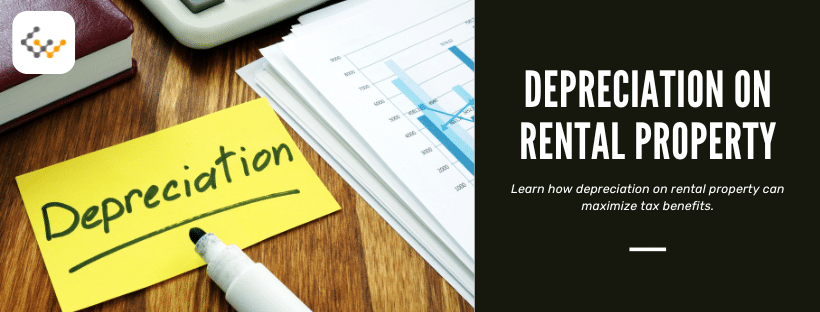Depreciation on Rental Property: Calculation & Requirements

Understanding depreciation is essential to accurately evaluating rental property financials. It’s used to evaluate expenses and returns, and IRS-allowed depreciation is eligible for a tax benefit. Here’s how to calculate the depreciation on a residential or commercial rental property.
What is Depreciation on Rental Property?
Depreciation accounts for tangible assets’ loss in value. It’s a financial method of factoring in the wear and tear that tangible assets sustain, and the corresponding maintenance required or loss in value.
How Does Rental Property Depreciation Work?
Depreciating rental property lets investors reduce their taxable income, thus reducing their tax liability. The Internal Revenue Service (IRS) allows the depreciation of rental property to be deducted as an expense against the income the property generates.
Per IRS rules, residential rental properties can be depreciated by spreading the cost of the building and improvements over a predetermined useful life span. Tax law stipulates that the predetermined time is 27.5 years for residential rental properties and 39 years for commercial rental properties.
The amount calculated isn’t a credit that reduces tax obligations by this amount. Rather, it’s a deduction that reduces taxable income. The exact amount that taxes are reduced by is a percentage of the depreciation amount, with the exact percentage depending on an investor’s tax rate.
Importantly, depreciation is only calculated on the rental property building and other improvements. Depreciation can’t be taken on land, which usually appreciates. Land can’t be depreciated per IRS rules, even in a falling real estate market.
In select situations, an alternative depreciation method must be used. This is generally only if a commercial property is used for business less than half the year, has a tax-exempt use, is financed by tax-exempt bonds, or is primarily used for farming or agriculture. These are pretty uncommon situations for commercial real estate investors with rental properties.
How to Calculate Depreciation on Rental Property
Calculating depreciation on a rental property is a straightforward process that involves two steps.
First, calculate the cost basis of the building and other assets apart from the land. You can generally get the cost basis of a newly purchased property by subtracting the land’s value from the purchase price. Determining the land’s value may require the assistance of a real estate agent or appraiser. Closing costs can usually be included in a cost basis, as they were costs paid in the acquisition of the property. Any improvements that are paid for can generally be added onto your initial cost basis, to determine a new cost basis each year.
Second, calculate the annual depreciation allowed using the property’s cost basis. Divide the cost basis for commercial properties by 39 years for a yearly amount. For small residential properties (not multi-family), use 27.5 years.
In the first year, the cost basis is prorated according to when the property was acquired. For commercial properties, this works out to about 0.214% of the cost basis for each month remaining in the year. The allowance is about 0.303% per month for residential.
Example of How to Calculate Depreciation on Rental Property
Consider an investment property purchased for $1 million to calculate depreciation on a commercial rental property. The land was valued at $300,000 when the property was closed. Closing costs were $50,000, and the purchaser made immediate improvements totaling $150,000 before renting.
The cost basis for this property would be $900,000.
Cost Basis = $1 million purchase price – $300,000 land value + $50,000 closing costs + $150,000 improvements.
The IRS-allowed annual depreciation would be $23,077.
Depreciation = $900,000 cost basis / 39 years
For a residential property, consider a single-family home that was purchased for $200,000. The land was valued at $25,000, and the closing costs totaled $15,000. There were no improvements made to the turn-key rental.
The cost basis for this residential rental property would be $190,000.
Cost Basis = $200,000 purchase price – $25,000 land value + $15,000 closing costs.
The IRS-allowed annual depreciation would be $6,909.
Depreciation = $190,000 cost basis / 27.5 years
IRS Requirements on Rental Property Depreciation
The IRS has specific requirements for depreciating rental property:
- Property Classification: The property must be a rental, used in a business or income-producing activity, and have a determinable useful life.
- Depreciation Start Date: Depreciation begins when the property is placed in service for rental purposes, not necessarily when purchased.
- Form 4562: Landlords generally should use IRS Form 4562 to report depreciation when filing taxes.
- Improvements vs. Repairs: Only improvements that increase the property’s value, prolong its use, or adapt it to new uses are depreciable. Routine repairs and maintenance can’t be depreciated.
If there’s any question about a property’s eligibility for depreciation, an accountant can help investors review their property in light of the IRS’s requirements.
What Happens to Depreciation When You Sell a Rental Property?
When a rental property, commercial or residential, is sold, the depreciation is recaptured. Recapturing means that the IRS taxes the portion of the sale proceeds attributable to previous years’ depreciation deductions.
Recaptured depreciation is currently taxed at an investor’s standard rate, subject to a maximum of 25%. It, along with capital gains taxes, may be deferred by completing a 1031 exchange. A 1031 exchange involves the sale of one investment property and the purchase of another.
Wrapping Up
If you’re investing in rental properties, understand how to calculate depreciation and its importance. The deduction that’s taken is an essential aspect of maximizing the financial return that a rental provides.

